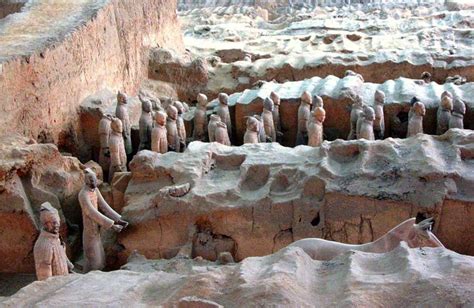why are chinese excavations mostly tombs Most of our knowledge about early China is derived from tomb excavations and the wealth of artifacts they have yielded. These discoveries give us important insight into early Chinese .
Learn about the most popular mini excavators on the market in 2023, including their features, specifications and applications. See models from John Deere, Yanmar, Caterpillar, .
0 · why were chinese tombstones found
1 · why china tomb is open
2 · why are china's tomb so invasive
3 · why are china's tomb ruined
4 · chinese tomb found
5 · china tomb problems
6 · china tomb archaeology
7 · ancient chinese tombs
Browse through Kubota's KX018-4 Compact Excavators tractor inventory, filter .
why were chinese tombstones found
mini digger theft insurance
why china tomb is open
A prime reason behind this hesitancy is that archeologists are concerned about how the excavation might damage the tomb, losing vital historical information. Learn the reasons why the underground palace of the First Qin Emperor remains unexcavated, such as limited technology, deep depth, long time, and environmental risk. Find . The Chinese government, respecting the cultural significance and the possible curse (yes, curses are taken quite seriously over there), has decided not to excavate the .
A fine example comes from the vicinity of the powerful ancient city of Liangzhu (south of Shanghai), which flourished from 3300 to 2200 BC. Excavations at nearby Fanshan . The tomb of Qin Shi Huang, China's first emperor, is a city-size complex of underground caverns with clay soldiers, concubines and treasures. Learn about the history, .Most of our knowledge about early China is derived from tomb excavations and the wealth of artifacts they have yielded. These discoveries give us important insight into early Chinese .

Learn about the discovery and significance of the clay army guarding the tomb of Qin Shi Huang, the first emperor of China. See photos and facts about the terra-cotta soldiers, . A significant number of tombs have survived from the Han dynasty (Western Han 206 BC-AD 8, Eastern Han 25–220), an important period for tomb architecture in China. The .
mini digger used uk
Learn about the burial complex of China's first emperor, Qin Shi Huang, and his terracotta army of 8,000 figures. Discover how the tombs were built, excavated and restored, . Qin tomb is the burial place of the first Qin emperor, who unified China and built the Great Wall. It contains a vast underground palace, a terra-cotta army, and other treasures, but the tomb itself remains unexcavated. A prime reason behind this hesitancy is that archeologists are concerned about how the excavation might damage the tomb, losing vital historical information. Learn the reasons why the underground palace of the First Qin Emperor remains unexcavated, such as limited technology, deep depth, long time, and environmental risk. Find .

The Chinese government, respecting the cultural significance and the possible curse (yes, curses are taken quite seriously over there), has decided not to excavate the . A fine example comes from the vicinity of the powerful ancient city of Liangzhu (south of Shanghai), which flourished from 3300 to 2200 BC. Excavations at nearby Fanshan . The tomb of Qin Shi Huang, China's first emperor, is a city-size complex of underground caverns with clay soldiers, concubines and treasures. Learn about the history, .
Most of our knowledge about early China is derived from tomb excavations and the wealth of artifacts they have yielded. These discoveries give us important insight into early Chinese .
Learn about the discovery and significance of the clay army guarding the tomb of Qin Shi Huang, the first emperor of China. See photos and facts about the terra-cotta soldiers, .
A significant number of tombs have survived from the Han dynasty (Western Han 206 BC-AD 8, Eastern Han 25–220), an important period for tomb architecture in China. The .
Learn about the burial complex of China's first emperor, Qin Shi Huang, and his terracotta army of 8,000 figures. Discover how the tombs were built, excavated and restored, .
Qin tomb is the burial place of the first Qin emperor, who unified China and built the Great Wall. It contains a vast underground palace, a terra-cotta army, and other treasures, but . A prime reason behind this hesitancy is that archeologists are concerned about how the excavation might damage the tomb, losing vital historical information. Learn the reasons why the underground palace of the First Qin Emperor remains unexcavated, such as limited technology, deep depth, long time, and environmental risk. Find . The Chinese government, respecting the cultural significance and the possible curse (yes, curses are taken quite seriously over there), has decided not to excavate the .
A fine example comes from the vicinity of the powerful ancient city of Liangzhu (south of Shanghai), which flourished from 3300 to 2200 BC. Excavations at nearby Fanshan .
The tomb of Qin Shi Huang, China's first emperor, is a city-size complex of underground caverns with clay soldiers, concubines and treasures. Learn about the history, .Most of our knowledge about early China is derived from tomb excavations and the wealth of artifacts they have yielded. These discoveries give us important insight into early Chinese . Learn about the discovery and significance of the clay army guarding the tomb of Qin Shi Huang, the first emperor of China. See photos and facts about the terra-cotta soldiers, .
A significant number of tombs have survived from the Han dynasty (Western Han 206 BC-AD 8, Eastern Han 25–220), an important period for tomb architecture in China. The . Learn about the burial complex of China's first emperor, Qin Shi Huang, and his terracotta army of 8,000 figures. Discover how the tombs were built, excavated and restored, .

Learn how to replace excavator buckets and bucket teeth, including tiger teeth, for different projects and conditions. Find out how to identify the correct tooth type, pin installation .
why are chinese excavations mostly tombs|why are china's tomb so invasive